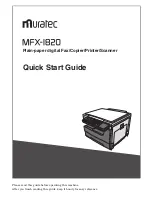
Quality control
Generic MICR Fundamentals Guide
6-13
3. Look at the suspect character to see if its right edge falls
between the two dotted lines defining the spacing tolerance
zone.
If the right edge of the character falls outside the dotted lines, it is
outside the ±0.010 inch/0.25 mm leeway and is out of
specification. It is also too close to, or too far away from, the
character on its right. Additional tolerances are required between
the fields in the MICR line to account for multiple printing steps.
If a spacing problem occurs, verify that the job was written
correctly and that the correct MICR font was used. Small spacing
variations that accumulate over many characters affect MICR
readability as long as the MICR line field boundaries are not
violated. They are frequently the result of failure to properly
specify character spacing or improper use of the spacing
algorithm.
Voids
The absence of ink is called a “void” or “deletion.” Voids can be
generated by excessive paper dust, a hardware problem, or
excessive paper moisture. This problem occurs more often with
cold fusion xerography and ionography technologies than with
hot fusion based xerography (like Xerox MICR systems).
Voids must be contained within a 0.008 inch/0.2 mm square. An
exception is made for internal voids that extend over two or more
zones of characters, a zone consisting of 0.013 by 0.013 inch/
0.33 by 0.33 mm square. For such a situation, a void must fit
within a 0.010 by 0.010 inch/0.254 by 0.254 mm square. The
squares on the MICR Gauge can be used to test this.
Single voids that are long, narrow, and predominately horizontal
or vertical are called “needle” type voids. They are allowed in any
length, anywhere in the character, provided they do not exceed
0.002 inch/0.05 mm in width.
The combined areas of all voids in any vertical column or
horizontal row (nominally 0.013 inch/0.33 mm wide) must not
exceed 20 per cent.
Summary of Contents for 6100BD - Phaser Color Laser Printer
Page 1: ...January 2003 701P22140 Xerox Document Services Platform Generic MICR fundamentals guide...
Page 17: ...Overview Generic MICR Fundamentals Guide 1 7 Figure 1 2 Life cycle of a check...
Page 22: ...Overview 1 12 Generic MICR Fundamentals Guide...
Page 46: ...Paper facts 3 18 Generic MICR Fundamentals Guide...
Page 74: ...Document design 4 28 Generic MICR Fundamentals Guide...
Page 86: ...Document processing 5 12 Generic MICR Fundamentals Guide...
Page 105: ...Quality control Generic MICR Fundamentals Guide 6 19 Figure 6 12 E13B characters and waveforms...
Page 146: ...Security 8 18 Generic MICR Fundamentals Guide...
Page 150: ...References A 4 Generic MICR Fundamentals Guide...
Page 164: ...Glossary Glossary 14 Generic MICR Fundamentals Guide...
















































